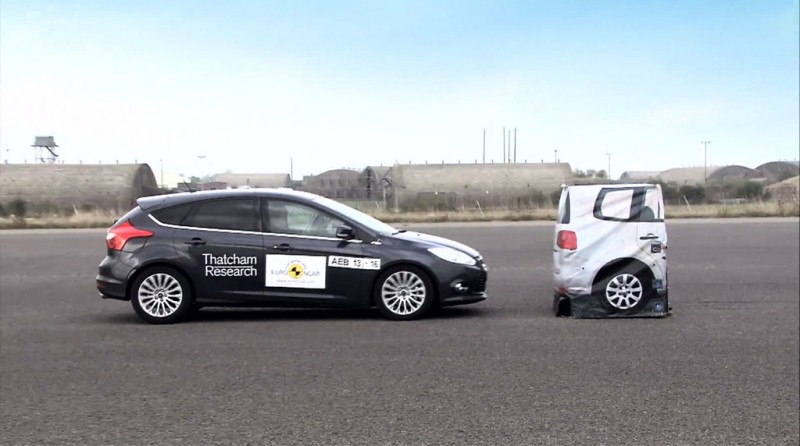Euro NCAP releases the first results of rear-end crash avoidance systems tested against the upcoming 2014 rating protocol. Eight vehicles have been compared with respect to their performance on the test track.
Real world claims data suggest that Autonomous Emergency Braking (AEB) systems can reduce rear-end crashes by one quarter or more and lead to a significant reduction of injuries. As from January 2014, Euro NCAP will in its rating scheme give credit to vehicle manufacturers that equip their models with robust forward collision warning and/or automatic braking technology.
The technologies available on the market today can be divided into groups based on the type of crash they are designed to mitigate. ‘AEB City’ works at low driving speeds and targets reduction in rear end shunts often associated with whiplash neck injuries. ‘Inter-Urban AEB’ works at higher speeds and targets fatal and serious injury crashes that may be caused by driver inattentiveness or distraction. Euro NCAP tests both types of systems and scores them between 0-3 points, which translates to Good, Adequate or Marginal.
Cars tend to travel at closer distance in slow traffic which minimizes the driver’s ability to avoid a crash at the last minute. As a result Euro NCAP focuses on the automatic braking function in its AEB City tests up to 50 km/h. Euro NCAP tested low speed AEB City system performance on 6 vehicles:
- Mercedes Benz E-Class – PRE-SAFE Brake – Good
- Volvo V40 – City Safety & Collision Warning with Full Auto-Brake – Good
- Mitsubishi Outlander – Forward Collision Mitigation – Good
- Volvo XC60 – City Safety – Adequate
- Fiat 500L – City Brake Control – Adequate
- Ford Focus – Active City Stop – Adequate
In this test, top marks were earned by PRE-SAFE Brake (3 points) on the Mercedes Benz E-Class; City Safety & Collision Warning with Full Auto-Brake (2.9 points) on the Volvo V40, and Forward Collision Mitigation on the Mitsubishi Outlander (2.1 points); whereas the systems on the Volvo XC60 (1.9 points), Fiat 500L (1.8 points) and Ford Focus (1.7 points) were rated as Adequate.
At higher driving speeds, there is often sufficient time for the driver to take action to avoid the crash. Therefore, AEB Interurban systems often provide a Forward Collision Warning function with enhanced braking performance, which can be complemented with an automatic brake function in case the driver does not respond to the warning. Euro NCAP assesses the system performance both where the driver brakes and where there is no reaction to the warning for their ability to avoid and mitigate crashes up to speeds of 80 km/h. The 5 vehicles tested for AEB Interurban are:
- Mercedes Benz E-Class – PRE-SAFE Brake – Good
- Volvo V40 – City Safety & Collision Warning with Full Auto-Brake – Good
- Volkswagen Golf VII – Front Assist – Good
- Mitsubishi Outlander – Forward Collision Mitigation – Adequate
- Honda Civic – Collision Mitigation Brake System – Adequate
The results in this test showed bigger differences between systems. The three best-scoring systems were: PRE-SAFE Brake (2.7 points) on the Mercedes Benz E-Class, City Safety & Collision Warning with Full Auto-Brake (2.6 points) on the Volvo V40 and Front Assist (2.2 points) on the VW Golf. The systems on the Mitsubishi Outlander rated as Adequate (1.9 points) and on the Honda Civic as Marginal (0.44 points).
In addition to the AEB tests, Euro NCAP has repeated the AEB Fitment survey of 2012 to see how AEB fitment has evolved in Europe. Manufacturers who had a system available last year continue to do so in 2013 and the rates of fitment have, in general, shown a modest increase over the last year. Unfortunately, most car makers still do not offer crash avoidance systems on any of their models.
Michiel van Ratingen, Euro NCAP Secretary General, says,
“With the limited number of systems available and tested, we can already see real differences in their performance and expected real world benefit. However we compliment the manufacturers of the systems in today’s launch, whether the system scored good, adequate or marginal, for already offering this technology onto their cars and hope that our results will help them to further develop their systems.”
Euro NCAP’s decision to include AEB in the rating reflects a growing awareness of the potential of these active safety systems and car makers are now clearly challenged to raise the availability and performance of AEB on new car models. The introduction of AEB along with Lane Departure Warning and Lane Keep Assist technology will define Euro NCAP’s ‘Year of Active Safety’ in 2014.
AEB technology is a support system that should not be overly relied upon by the driver. In more challenging situations, AEB activation may not be sufficient or not timely enough to avoid a crash completely, although the resulting impact speed may be significantly reduced. According to Euro NCAP, good occupant protection remains vital to avoid serious consequences.
Source; Euro NCAP

